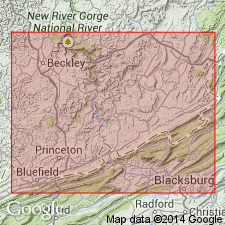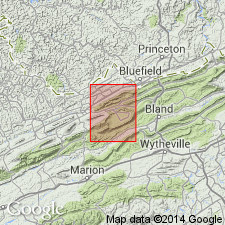
- Usage in publication:
-
- Bratton sandstone
- Modifications:
-
- Original reference
- Dominant lithology:
-
- Sandstone
- AAPG geologic province:
-
- Appalachian basin
Summary:
Pg. 293, 317. Bratton sandstone. Green, flaggy, or massive, fine-grained sandstone, 5 to 20 feet thick. Underlies Hunt shale and overlies Bratton shale (all members of Bluestone group [Bluestone formation]). Type locality near extreme head of Bratton Branch of Brush Creek, in Mercer Co., southeastern West Virginia. Age is Mississippian.
[The Bluestone group is a term used by some geologists to include same rocks as Bluestone formation of USGS reports (US geologic names lexicon, USGS Bull. 896, p. 222).]
Source: US geologic names lexicon (USGS Bull. 896, p. 255).

- Usage in publication:
-
- Bratton sandstone member
- Modifications:
-
- Areal extent
- Redefined
- Dominant lithology:
-
- Sandstone
- AAPG geologic province:
-
- Appalachian basin
Summary:
Pg. 185, pl. 15. Geographically extended into Virginia and redefined as member of Bluestone formation. Thickness about 10 feet. Overlies Belcher member; underlies Bent Mountain member (new). Consists of greenish-gray, micaceous, silty sandstone.
Source: US geologic names lexicon (USGS Bull. 1200, p. 458).
For more information, please contact Nancy Stamm, Geologic Names Committee Secretary.
Asterisk (*) indicates published by U.S. Geological Survey authors.
"No current usage" (†) implies that a name has been abandoned or has fallen into disuse. Former usage and, if known, replacement name given in parentheses ( ).
Slash (/) indicates name conflicts with nomenclatural guidelines (CSN, 1933; ACSN, 1961, 1970; NACSN, 1983, 2005, 2021). May be explained within brackets ([ ]).

